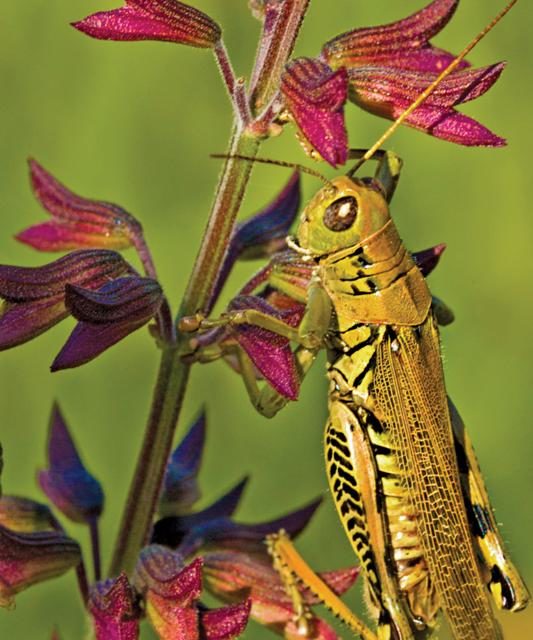Grasshoppers have a superpower: jumping. If humans jumped as far relative to our size, we could leap over five-story buildings and cover the length of a football field in three bounds.
The grasshopper’s hind legs, strong as they are, can’t perform such feats unaided. It first compresses a “spring” in its hind legs, storing energy under tension. Releasing the spring flings the grasshopper forward.
We do not know how and when this jumping mechanism developed, but it’s served them well: grasshoppers have been around in one form or another since before there were dinosaurs.
The dapper species featured in our photos is the differential grasshopper. Erika Tucker, insect collection manager at the U-M Museum of Zoology guesses that it may have been named for the distinctive herringbone pattern on its legs.
Tucker explains that it winters as an egg, one of a pod buried in a shallow hole. Come late spring, the eggs hatch into nymphs. These emerge, pass through several stages (called instars), progressively grow wings, and enjoy the summer. We will probably not see full-size adult differentials until sometime late next month, but Tucker tells us that many other grasshopper species come out in June.
Differentials like warm sunny days. After resting overnight in higher vegetation, they descend to bask in the sun and eat. When it gets too hot, differentials will find some shade or fly to cooler elevation.
This pleasant existence is not without its dangers. Birds, frogs, and large spiders are among those who prey on grasshoppers. When too many differentials eat too many cultivated plants, there can be war between human and grasshopper.
In a small garden, grasshoppers may be regarded more as a source of entertainment and education than as a pest. But what’s okay in a garden may not be okay in a farmer’s field. Tucker links the type of environment to the extent of the problem. When plants are part of a monoculture–like a field devoted entirely to corn–a large number of grasshoppers may destroy the entire crop.
In a garden with well-spaced and diverse plants, the impact is much less: “a nibble here or there,” says Tucker. In public gardens such as Matthaei Botanical Gardens or County Farm Park, where management is loath to use insecticides and damage is minimal, grasshoppers are left alone.
Grasshoppers eat everything from grass to flowers, so look for them in meadows, parks, and backyards. Try having a staring contest: Tucker points out that if a grasshopper decides you are a threat, it may slowly scooch around to the backside of a stem in an effort to hide. It may have a superpower, but we are still bigger.


